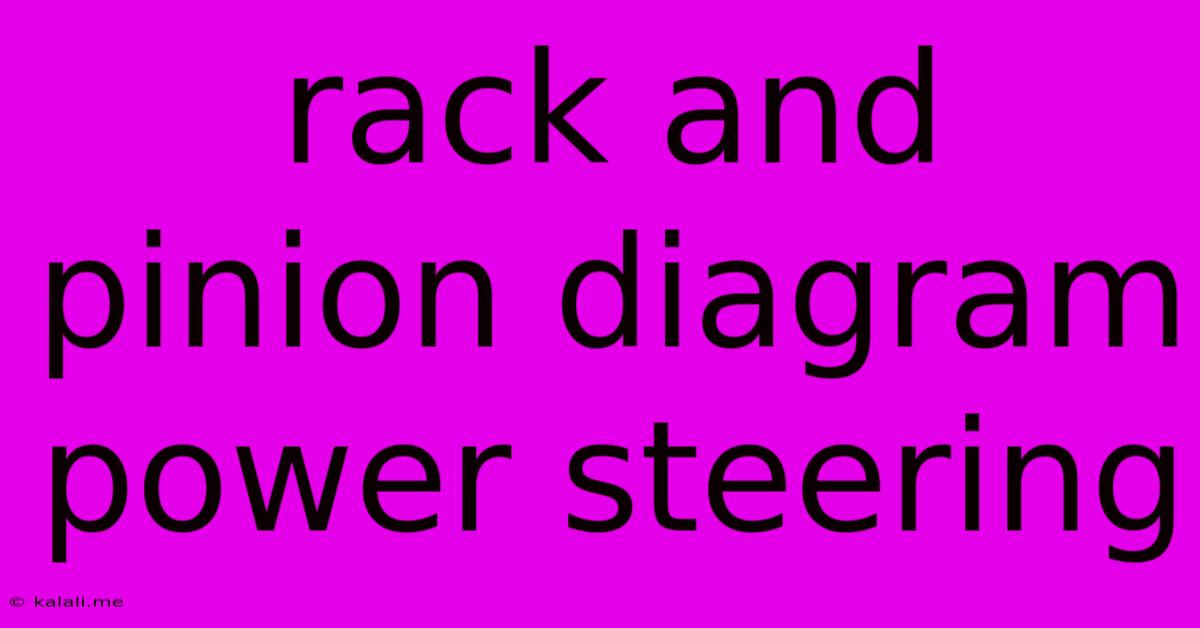Rack And Pinion Diagram Power Steering
Kalali
Jun 13, 2025 · 3 min read

Table of Contents
Understanding the Rack and Pinion Power Steering System: A Comprehensive Diagram and Explanation
Power steering systems are vital for comfortable and safe driving, especially in modern vehicles. The rack and pinion system is the most common type found in cars today, offering a direct and efficient way to translate steering wheel movement into wheel turning. This article will provide a detailed explanation of the rack and pinion power steering system, complemented by a conceptual diagram to enhance understanding. This will cover the components, their functions, and how they work together.
The rack and pinion system is a relatively simple yet effective mechanism that uses a gear (the pinion) to move a bar (the rack). This movement then translates directly to the turning of the wheels. The inclusion of a hydraulic power assist makes the steering much lighter and easier, especially at low speeds.
Key Components of a Rack and Pinion Power Steering System:
A functional rack and pinion power steering system consists of several key components:
-
Steering Wheel: The input device, initiating the steering process. Rotating the steering wheel is the first step in turning the car's wheels.
-
Steering Column: Connects the steering wheel to the pinion gear. It transmits the rotational force from the steering wheel.
-
Pinion Gear: A small circular gear that meshes with the rack. The rotation of this gear causes the rack to move linearly.
-
Rack: A straight bar with teeth that mesh with the pinion gear. The linear movement of the rack directly translates to the turning of the wheels.
-
Tie Rods: Connect the rack to the steering knuckles on the wheels. The movement of the rack is transferred to the wheels via these rods.
-
Steering Knuckles: These pivoting parts connect the tie rods to the wheels, allowing the wheels to turn.
-
Hydraulic Power Steering Pump: Driven by the engine, this pump provides the hydraulic pressure needed to assist the steering.
-
Power Steering Reservoir: Stores the hydraulic fluid for the system.
-
Pressure Hose: Carries high-pressure hydraulic fluid from the pump to the power steering gear.
-
Return Hose: Carries low-pressure hydraulic fluid back to the reservoir from the power steering gear.
-
Power Steering Gear (Rack and Pinion Assembly): Houses the rack and pinion and incorporates valves to control hydraulic fluid flow. This is where the hydraulic assistance is applied.
-
Control Valve: Regulates the flow of hydraulic fluid to the rack, providing assistance based on the steering input and the load on the wheels.
How it Works:
- The driver turns the steering wheel.
- The rotation is transferred through the steering column to the pinion gear.
- The rotating pinion gear moves the rack linearly.
- This linear movement is transmitted through the tie rods to the steering knuckles.
- The steering knuckles turn the wheels.
- The hydraulic power steering pump provides assistance, making the steering effort much easier. The control valve regulates the hydraulic fluid flow to assist the driver's input. More steering effort requires more hydraulic assistance.
Conceptual Diagram:
(Imagine a diagram here showing a simplified representation of the system. It should include the steering wheel, steering column, pinion gear, rack, tie rods, wheels, and the power steering pump and reservoir connected to the rack and pinion assembly. Arrows should indicate the direction of force and fluid flow.)
Troubleshooting Common Issues:
While generally reliable, rack and pinion power steering systems can sometimes experience problems. Common issues include leaks in the hydraulic lines, pump failure, and wear and tear on the rack and pinion assembly itself. These issues often manifest as difficulty steering, unusual noises, or fluid leaks.
This comprehensive explanation, along with a visualization of the system (consider creating your own diagram based on this description), should provide a thorough understanding of the rack and pinion power steering system. Remember, regular maintenance, including checking fluid levels and inspecting for leaks, is crucial for optimal performance and longevity.
Latest Posts
Latest Posts
-
Act Requirements For Missouri State University
Jun 14, 2025
-
What Is The Bodys Natural Anticoagulant
Jun 14, 2025
-
Area Of The Region Bounded By The Curves Calculator
Jun 14, 2025
-
Difference Between Keratinized And Non Keratinized Epithelium
Jun 14, 2025
-
A Hard Disk Drive Is An Example Of Magnetic Storage
Jun 14, 2025
Related Post
Thank you for visiting our website which covers about Rack And Pinion Diagram Power Steering . We hope the information provided has been useful to you. Feel free to contact us if you have any questions or need further assistance. See you next time and don't miss to bookmark.